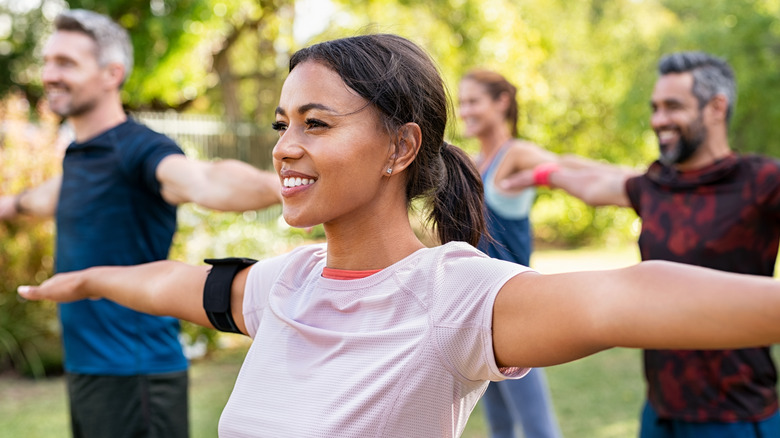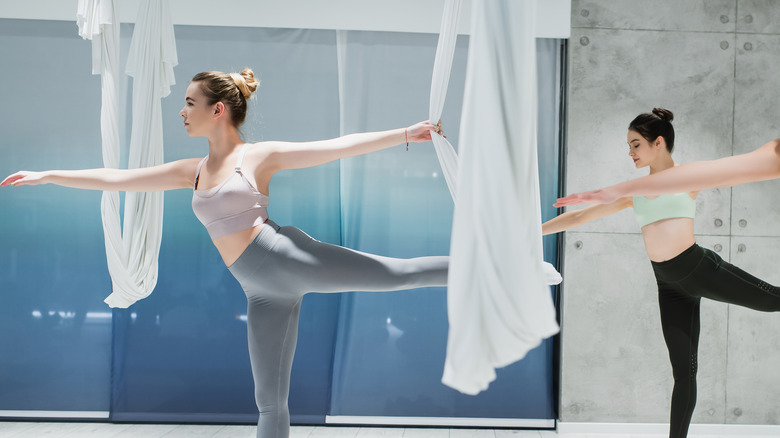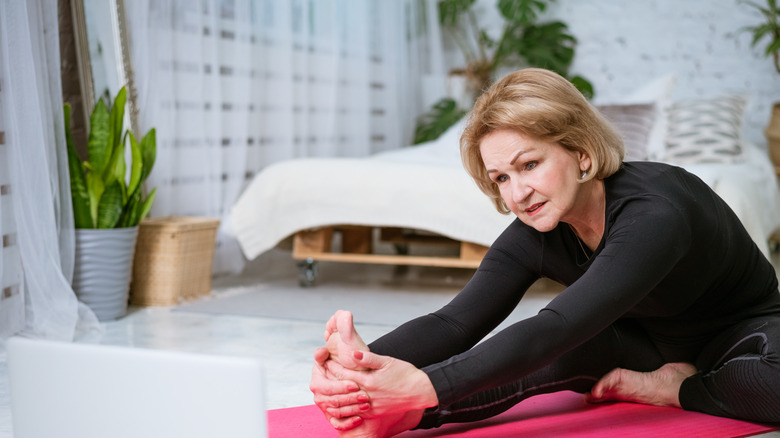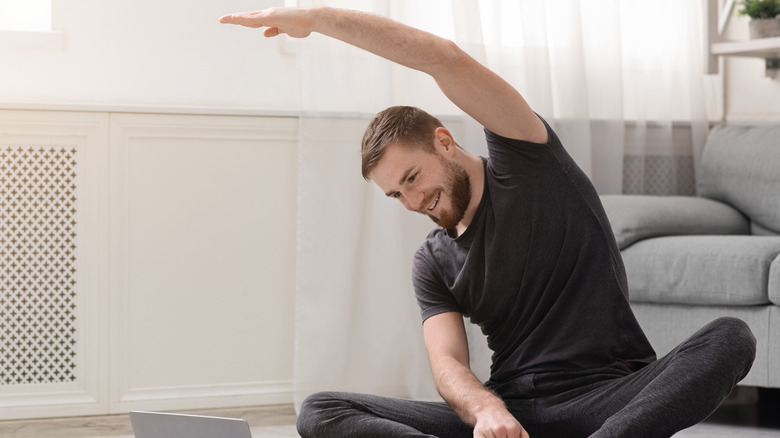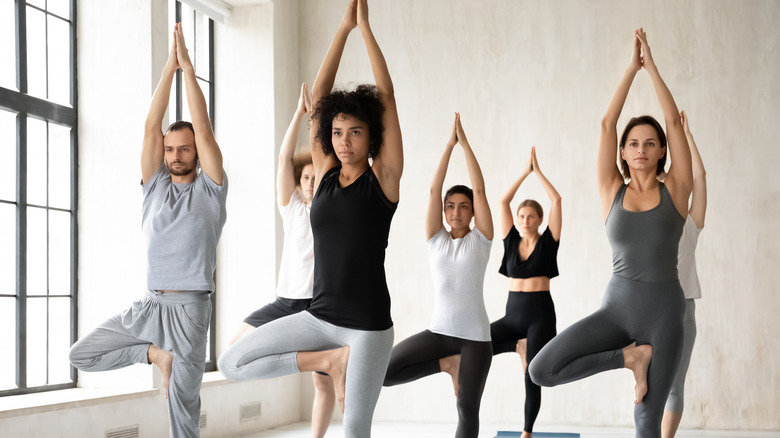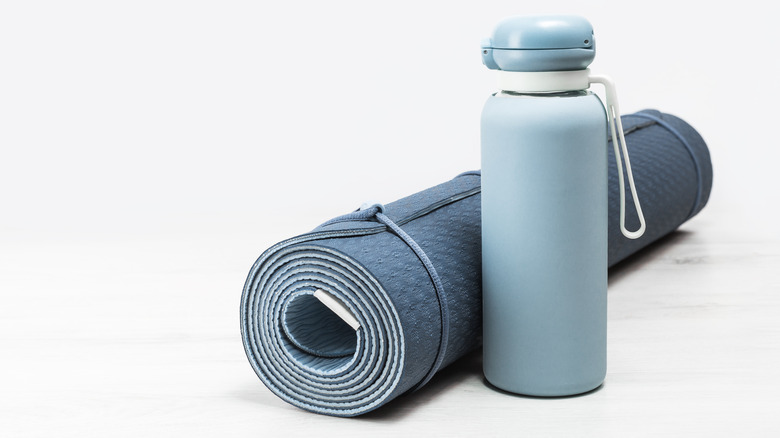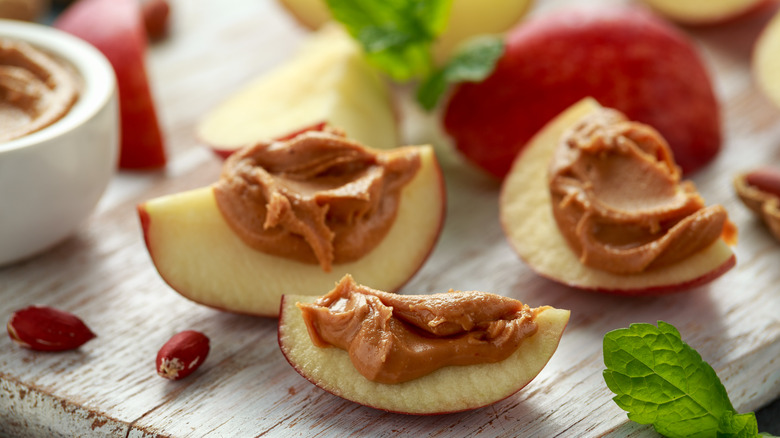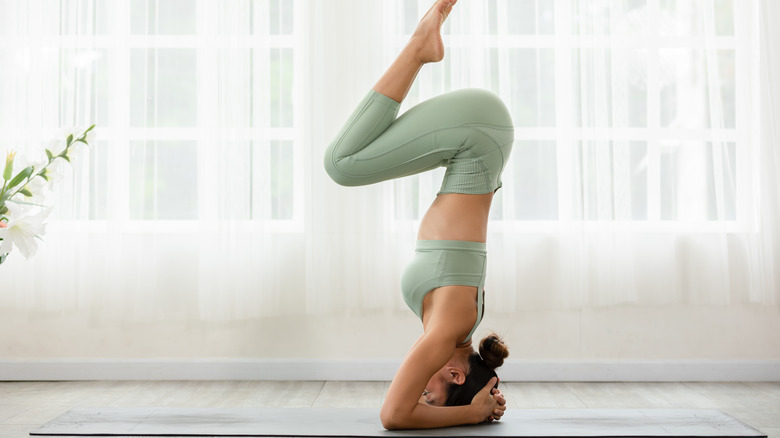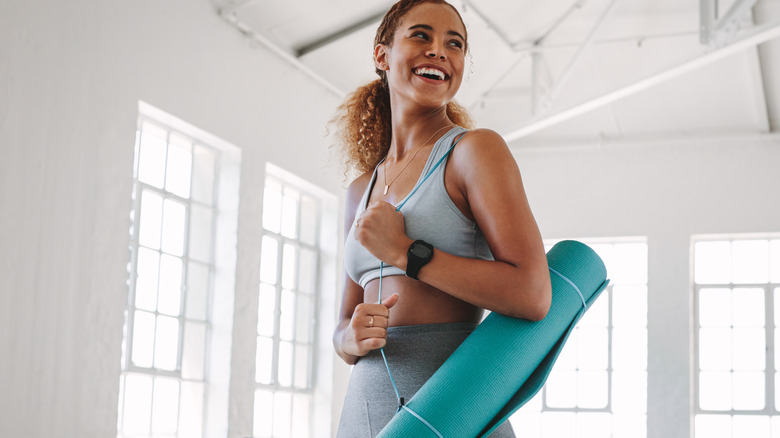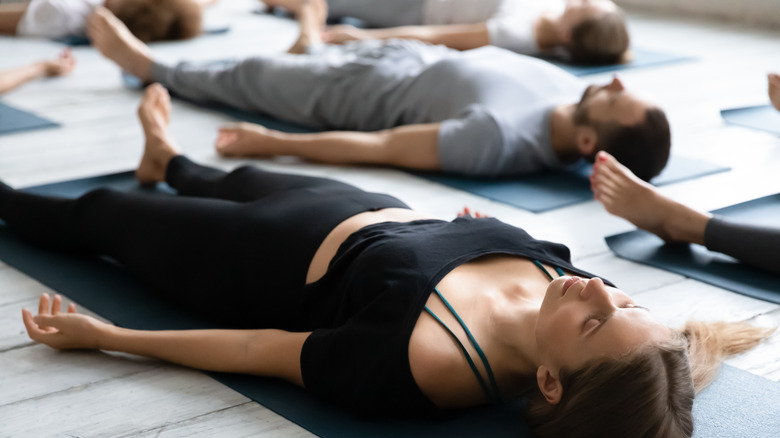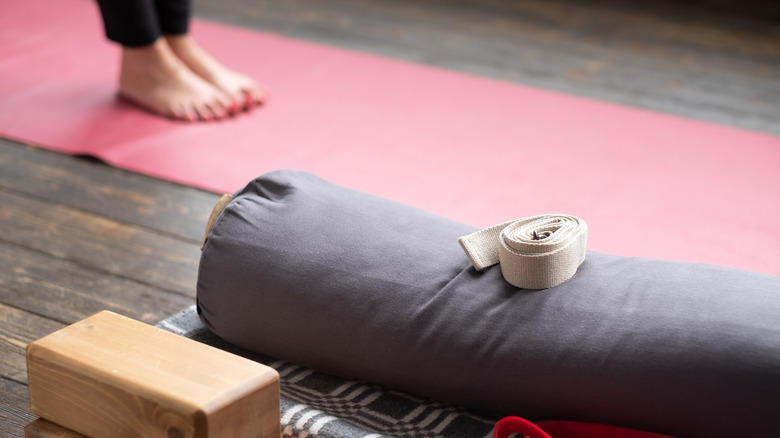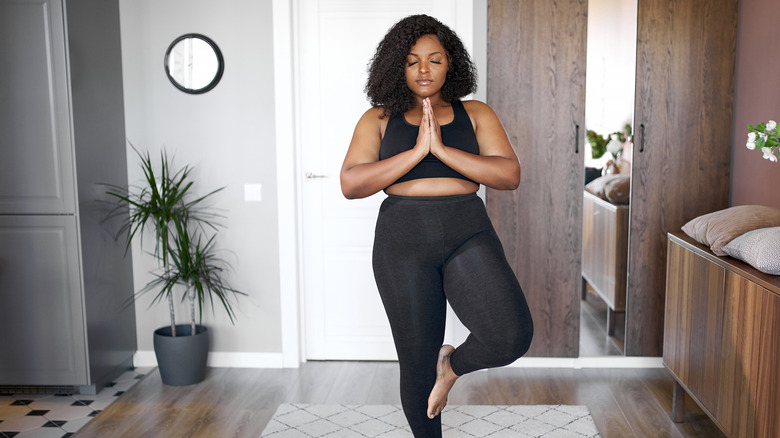Everything Beginners Need To Know About Yoga
If you're someone who's heard of yoga before but hasn't tried it, you probably have a number of hesitations or doubts about the practice and whether or not it's appropriate for you. There's a lot to learn about this ancient form of movement, but don't let that stop you from taking the leap and giving it a try. According to experts at Healthline, yoga is much more than just downward-facing dog and other stately postures you may have seen in health magazines. It's a combination of meditation, breathing, and other spiritual components that make it such a well-rounded practice.
Because there are non-physical aspects of yoga as a discipline, it's an activity that can be practiced by people of all ages and levels of physical fitness, according to Healthline. There are numerous benefits to practicing the physical component of yoga including increased energy, decreased stress, improvements in physical strength, and much more. If you are just starting out on your yoga journey and want to learn more about the practice, continue reading to discover 14 things every beginner needs to know before getting started.
Yoga is an ancient practice
While the amount of modern day variations of yoga are endless (yoga on a paddle board, yoga holding your dog, yoga on a horse), the practice of yoga dates back 2,000 years in India, according to Yoga Journal, and actually began as an oral tradition to help humans master their thoughts, emotions, and grow spiritually. The tradition was developed by an Indian sage named Patanjali who created a "collection of 195 statements," also known as The Yoga Sutra, that would continue to be passed down from teacher to student.
The physical component of yoga, which is also known as hatha yoga, was introduced as a way to help calm the body and nervous system, thus calming the mind and preparing it for meditation. According to experts at Yoga Journal, the word "hatha" is a combination of the sanskrit words ha or "sun," and tha, or "moon," which together means "a union of the pairs of opposites." The word yoga itself comes from the Sanskrit word "yug," which experts at Yoga Journal say translates to "to hitch up," as well as "yoke, join, or concentrate." A more modern day definition according to the site could simply mean a "method of discipline."
There is more than one type of yoga
If you've ever felt overwhelmed at the sheer variety of yoga styles, you're not alone. The good news about the numerous disciplines of yoga is that there truly is a class for everyone. Yoga experts spoke to Women's Health UK and broke down different types of yoga in layman's terms for those who might be new to the practice. Starting with Hatha, Dr. Nitasha Buldeo, yoga instructor and founder of Organic Apoteke and I-Yogaa explained, "Hatha is traditionally about creating balance in the autonomic nervous system by following strengthening poses with poses that are relaxing and improve flexibility. Breath also plays an important part in the practice of Hatha Yoga. Together, breath and movement create balance in body and mind."
Next, experts discussed Vinyasa, which is a type of yoga whose name literally translates to "flow," and generally refers to the way that each pose flows into the next. This type of yoga is good for those who want a meditative, yet strengthening experience. Ashtanga is another type of yoga that is more dynamic and it "builds internal heat," according to Jonathan Sattin, founder of triyoga. While those are only three types of yoga, experts at Women's Health lay out a total of 13 different types that vary in intensity for all levels of experience.
You should opt for comfortable, form fitting clothing
If you're new to yoga you may think you can throw on any type of workout gear. However, in order to get the most out of your class, yoga does require a somewhat specific set of clothes. According to experts at Self, the best clothes to wear to yoga are fitted. Amy Opielowski, San Diego–based master trainer at CorePower Yoga spoke to the site and explained that of course, the first rule of order is that your clothes should be comfortable.
The clothes should allow you to "move, stretch, and breathe with ease," she explains, while also wicking away sweat. A fitted top or sports bra are best for up top, and if you do decide to wear a t-shirt, she suggests tucking it in so that it doesn't slide up when you're in downward dog. While leggings are certainly the most popular option, you can also wear shorts if they allow you to move easily without having to adjust them.
Be aware that yoga has a history of cultural appropriation
While engaging in cultural practices that are not your own, there is always the potential for cultural appropriation no matter how uncomfortable it is to think about. According to experts at Verywell Mind, cultural appropriation refers to the act of using "objects or elements of a non-dominant culture in a way that reinforces stereotypes or contributes to oppression" while misinterpreting the meaning and without giving due credit. Another definition is simply using aspects of someone's culture without their permission, according to the site.
So how does yoga fall into this category? Arundhati Baitmangalkar, yoga teacher, studio owner, and host of the Let's Talk Yoga podcast, spoke to Yoga International about her experience having been born and raised in India and now offering training and courses in the United States. She starts off by mentioning the use of the word "yogi" to describe anyone who does yoga, explaining that the term is used only for "someone who practices all the limbs of yoga intensely," which may even include renouncing all possessions. This is just one example however, and to avoid any other forms of cultural appropriation while practicing yoga, Baitmangalkar suggests doing your own research first, and taking classes with Indian and South Asian yoga teachers as a way to learn more.
You don't need to be flexible to start yoga
While you might be intimidated by the way some people seem to contort themselves into unusual or even painful-looking poses, knowing how to do this yourself is not a requirement to start doing yoga. According to experts at Everyday Health, the intention of yoga is to make you flexible. Samantha Clayton, International Sports Science Association certified yoga instructor and National Academy of Sports Medicine certified personal trainer based in Los Angeles spoke to the site and explained, "We all have to start somewhere, and each pose can be modified to fit where you are on your own personal flexibility journey."
The site explains that yoga is a great exercise for people at any fitness level, and being flexible or in shape is not necessarily a requirement. Experts at Verywell Fit echo this sentiment and explain that if a pose requires you to touch your toes, for example, you can modify it by bending your knees. Kelly DiNardo, a 200-hour Registered Yoga Teacher, and the co-author of "Living the Sutras" explained "Whether or not you're flexible should not dictate whether you practice. Over time, yoga can help you become more flexible—that's why we call it practice—but you don't have to be Gumby-like to start. Flexibility is a result of yoga, not a prerequisite."
Be conscious of where you place your mat
If you're new to the world of yoga you might be surprised to know that there is actually a certain amount of etiquette engrained in the practice that's important to follow. There are some common courtesies like turning off your cell phone, making sure you shower beforehand, and not talking during class that may seem like common sense — but another not-so-commonly thought about aspect of yoga is where you place your mat. Yoga teacher trainer Coral Brown spoke to Yoga Journal about this element of the practice and explained that your motivation for placing your mat in the front, back, middle, or sides can actually give you insight into where you need to do the most work.
She explains further, saying, "Are you attached to that spot because that's where you always go? Then, you should practice non-attachment (vairagya). If you see other students come in and you spread out and stack your blocks so that nobody takes the spot next to you (so you won't feel crowded), you should practice non-greed (aparigraha)." She continued explaining that if you place your mat in the front of the studio to be in better view of the teacher, that shows you are motivated to improve your focus.
Hydrate before and after
Staying hydrated is a key element of any workout, and although yoga may not seem like a strenuous exercise, drinking water both before and after yoga is important to avoid dehydration. Kara Lydon, RD, Boston-based nutritionist and yoga instructor spoke to Yoga Journal and said "Hydration pre-yoga is essential to avoid stiffness and cramping." Experts at Everyday Health confirm that cramping can be a symptom of dehydration during exercise due to changes in the amount of sodium and potassium in the blood, and the heat that is generated from the body.
Furthermore, the site explains that reaching for a drink with electrolytes may further lower the risk of experiencing muscle cramps when compared to drinking plain water. With that said, Lydon cautions against chugging a glass of water before class to avoid feeling full and bloated. She instead suggests sipping on a 16-ounce glass of water an hour before class. After class it's important to rehydrate to replace any fluids lost, especially if you participated in a hot yoga class. Experts at Yoga Journal suggest drinking at least 20 ounces after class is over.
Be aware of what you eat before class
Like chugging a giant bottle of water before class, eating a large or heavy meal pre-yoga may also have some uncomfortable consequences. Experts at Verywell Fit explain that while eating a large meal before yoga is not advisable, you can still enjoy a snack before you head to class, and in some cases it should be encouraged. While of course, each body is different, there are some across-the-board recommendations regarding what and when to eat. Experts explain that consuming something "very light" about an hour before class should typically be fine.
Especially if you are quite hungry before class, a protein or carbohydrate-based snack can provide enough fuel to get you through. The site suggests light snacks such as an apple with peanut butter — which provides fiber and protein — as well as berries and yogurt. Nuts, protein bars, and oatmeal are also good choices. In terms of what to avoid, the site says to steer clear of foods that may lead to gas, as well as any greasy or fried foods such as a burger with fries. Surprisingly, the Verywell Fit recommends staying away from hard boiled eggs, as they can cause "sour burps" during class. Garlic is another food to stay away from for politeness' sake because of the potentially strong odor they induce.
Your digestion may improve
On the subject of food, there are in fact some positive side effects yoga can have on your digestive system. If you are someone who struggles with digestive issues, you may have already tried a host of options before landing on yoga as a solution. Experts at Healthline loosely define digestion as "the breakdown of food to provide your body with nutrients and expel waste products." However, some may understand it to be an overarching term that encompasses all things related to gut health including gas, bloating, and stool health.
There are several different factors that influence digestion, including both psychological and physical stress, according to experts at the site. Ways that yoga may help with digestion include lowering said stress, improving circulation, and simply creating more physical movement in the gastrointestinal tract. For those who deal with Inflammatory Bowel Disease, which includes symptoms like abdominal pain, cramping, and diarrhea, yoga has been shown to provide relief. A study published by the International Journal of Yoga Therapy found that those who had the disease and practiced eight weeks of consistent yoga saw considerable relief of their symptoms.
Don't expect immediate results
It's understandable — you see the svelte, toned bodies of people practicing yoga and want nothing more than to look just like them. The way many people are wired has them wanting fast results — but according to the seasoned pros, the flexibility, toning, and strength that comes as a result of yoga may require a bit of patience. If you're looking for a specific time frame of when you'll get to your desired level of fitness, well, the answer isn't so clear cut. Experts at Livestrong explain that this will depend on how "in shape" you already are, what your goals are, as well as what type of yoga you're doing.
Len Kravitz, PhD, University of New Mexico, spoke to the site and explained that regarding flexibility and strength, it may take a few weeks of practice before you can get into some of the tougher yoga poses. He says that you should see results after approximately 16 sessions, and that during this time your body is learning to "work smarter as you push it harder." Regarding your cardiovascular health, experts at Livestrong cite a study published by the International Journal of Environmental Research and Public Health that saw subjects' cardiovascular health improve after just two weeks of engaging in intensity exercise training, such as vinyasa yoga which is a type of class that has you flowing from one pose to the next.
You'll need to find the right mat
While there will typically be mats available to use at your studio of choice, buying your own yoga mat has its advantages. According to experts at Verywell Fit, shared mats are likely to be a breeding ground for some scary bacteria, including staph and different types of fungus resulting from sweat and other bodily fluids. Before you think about trying to skip out on a mat, experts at the site say they are pretty much necessary to provide traction and cushioning as you move through your poses.
The site explains that mats can run anywhere between $25 and $140 depending on the materials and the brand, and that higher priced mats may last longer if they are made from high quality materials. Three different types of mat materials you're likely to find are Polyvinyl Chloride (PVC), rubber, and Thermoplastic Elastomer (TPE). PVC mats are on the cheaper end of the spectrum, are made from non-biodegradable material, and typically take a while to wear-in, although they provide good traction. Rubber mats are renewable and biodegradable, are heavier in weight, and are typically great for gripping. TPE mats are biodegradable and lightweight, but may not last as long as the others.
Don't skip savasana
If you've had a long and intense yoga practice, you may be looking forward to the sweet relief of savasana at the end of your class. On the other hand, there are some that may find the rest at the end of the class boring, or frustrating at worst, and want to skip it all together. Although it may not seem like much is happening, experts at Yoga Journal extoll the benefits of savasana, going as far as calling it the most important pose in the practice.
Annie Carpenter, yoga teacher and creator of SmartFLOW Yoga spoke to Yoga Journal and explained, "Savasana is the great balancer in terms of our nervous system: while much of asana practice is designed to up-regulate the body, stimulate, and even provide healthy stress, Savasana is the down-regulator. It shifts the [sic] away from the sympathetic nervous system to the parasympathetic side, and we experience a calming, sweet release."
She goes on to explain that this pose can actually help your nervous system become accustomed to down-regulating automatically when in high states of stress, which can help you improve your digestion and even your immunity. Other experts at the site point out that committing to a full 10-minute savasana can help quiet the mind, and release excess mental chatter.
You may need extra equipment
While some classes only require a mat and your physical presence, others ask for a bit more. Experts at Verywell Fit explain that particularly for beginners, yoga props can help support your body as you move through different poses, helping you to maintain proper alignment and prevent injury. Blocks can be used for a variety of purposes, one of which is to help you while bending if your hands are meant to touch the floor. Experts at the site explain that the block prevents you from having to "compromise" the pose, by allowing your chest to remain open and preventing you from having to bend your knees, or preventing your chest from turning to the floor.
Blocks can be made from cork, wood, or foam, and can be propped on any side. Straps are another common prop that are used for poses that require you to reach and hold your feet. Experts at the Verywell Fit say the strap essentially acts as an extension of your arms, allowing you to reach without straining. Bolsters, which look like a long tube-like pillow, can be used to sit on, making certain poses that require you to sit or bend forward more comfortable.
You can do yoga at home
If you're sheepish to join your first in-studio yoga class, simply don't have the time, or want to save a few dollars, building an at-home yoga practice may be the way to go. Experts at Verywell Fit provided tips on exactly what you'll need to do to get the most out of your practice at home, starting with making sure you have the right gear. As previously mentioned, a yoga mat and all the extra props can greatly support your yoga practice, so making sure you have those things on hand is a good place to start.
Veronica Parker, Kundalini yoga teacher and meditation coach, spoke to the site about the importance of finding the right space. "It's ideal to have a space that's free of clutter. This could be a bedroom, basement, or living room area." She goes on to say that making the space feel like it was meant for yoga and not doing anything else there is ideal. She also suggests finding your flow, which essentially means finding the classes and the instructors that work best for you, and sticking with it. She recommends streaming services such as Gaia, which have a variety of teachers, as well as apps like Asana Rebel if you are "on the go."

